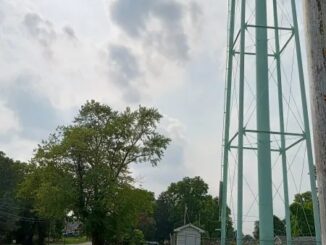
Renovating a 50-year-old landmark structure in the heart of the nation’s capital is expected to save dozens of low-income Virginia families thousands of dollars on their electric bills.
It’s possible because of a new green pledge between neighboring entities that is simple yet trailblazing.
The District of Columbia-based American Institute of Architects (AIA) will offset greenhouse gas emissions generated from its major modernization by funding the bulk of 360 kilowatts of solar power on the roofs of Habitat for Humanity Virginia homes.
Jeff Heie, who directs the nimble startup Give Solar, will coordinate the installations over the next two years. AIA’s $500,000 donation will cover enough panels for 72 houses, he estimated.
“It’s huge,” the solar champion said about the gift’s role in crushing barriers to renewable energy.
Two years ago, he initiated a Give Solar-Habitat Virginia partnership via a pilot project with the housing nonprofit’s Central Valley affiliate. Both organizations are based in the Shenandoah Valley’s Rockingham County.
Sign up for Energy News Weekly
Get the most important energy news of the week delivered directly to your inbox.
Since then, due to Heie’s doggedness, more than half of the 39 Habitat Virginia affiliates have either completed solar conversions or expressed interest in doing so.
“What makes me feel good about my work is getting solar in the hands of people who just don’t have access,” Heie said. “It’s part of lifting up low-income people and helping them break out of cycles of poverty.”
The first inkling of AIA’s interest in Give Solar’s ties with Habitat arrived in Heie’s email inbox as a vague query from a San Francisco architectural firm in October 2021. That tickler launched negotiations that led to the announcement of the joint AIA-Habitat pact in late February.
“The way I look at it, this donation is buying us some time to figure out how to make this an ongoing sustainable model for installing solar on Habitat homes.”
AIA anticipates breaking ground this year on the transformation of its iconic Brutalist style headquarters built in 1973, and adjacent courtyard and garden. The overhaul will fully electrify the building, reduce energy use by 58% and tap into a 100% renewable energy mix.
The professional trade group, not the homeowners, has dibs on the solar renewable energy credits because it’s the entity offsetting the carbon emissions.
“We are excited about AIA’s building renewal, and we appreciate Habitat for Humanity’s assistance to address the embodied carbon from the project,” said association CEO Lakisha Ann Woods. She added that the decarbonization goals demonstrate a cost-effective and replicable approach to climate action.
We want your feedback!
The Energy News Network wants to hear your thoughts so we can improve our coverage and newsletters. Help us out by taking this short survey.
‘Soft opening’ in Fauquier County
Give Solar delved into its first AIA-Habitat rooftop array a week earlier than the scheduled March 1 start date to accommodate the schedules of some volunteers.
“It was like a soft opening,” Heie joked about the Feb. 24 installation on a new two-story home in the Northern Virginia town of Warrenton.
That yet-to-be-occupied Fauquier County house fills the bill of the 70-plus homes Give Solar will be outfitting with 5-kilowatt systems. Generally, Habitat homes, modestly sized between 1,200 and 1,400 square feet, are models of energy efficiency.
Thus far, Heie has lined up six small solar developers across the state willing to provide labor and materials at a discounted sum of $10,000 per 5-kilowatt system.
“A connection with Habitat is a valuable asset because companies can show how they are community-oriented,” Heie said. “We’re reaching audiences who would otherwise be shut out. Installers like that message.”
AIA dollars cover equipment. The price tag of the 12 to 14 panels for each house, plus racking, wiring, inverters and other materials, add up to $6,300 of that total. The remaining $2,700 is the cost of labor.
Habitat homeowners will cover that balance by rolling a little extra — an estimated $11 to $23 — into their monthly mortgage payment.
“This is so homeowners have skin in the solar game,” he said. “Habitat builds affordable, subsidized housing and it doesn’t give that away for free either.”
The family that eventually moves into the Warrenton home — served by Dominion Energy — will lower its electric bills by $65 to $75 monthly. That amounts to a whopping $27,000 in savings over the 25-year “lifespan” of the array, assuming electricity costs rise 2% annually.
“Statewide, Habitat homeowners will be benefiting from solar much more than they are paying in,” Heie said. “I see it this way: we’re putting money back into pockets and contributing to generational wealth.”
Most families served by Habitat affiliates in Virginia earn between 25% and 60% of the area median income, according to the nonprofit’s statistics.
Executive director Overton McGehee, who oversees all Habitat Virginia affiliates, traveled to Warrenton from his Charlottesville office to witness the Feb. 24 event.
“This is big,” he said about the financial boost from AIA. “It will save hardworking, low-income homeowners money on their electric bills.”
He referred to the embrace of rooftop solar as Habitat Virginia’s “second big leap forward in sustainability.” The first jump involved the adoption of stricter energy efficiency standards about 17 years ago.
Give Solar is in the midst of creating a how-to video for Habitat builders that lays out solar-ready construction practices. For instance, crews are instructed to run conduit from the electric panel to the attic before drywall is in place.
“Going forward, we hope all Habitat houses with suitable roofs will have solar panels,” said McGehee, who initially connected with Habitat decades ago as a volunteer. “It’s just so logical and the technology is so far ahead.
“We were excited about solar in the Carter administration and now it’s so much more advanced.”
Conservation rooted in family tree
At the Warrenton installation in late February, an energetic Kim Monge Fera, operations manager with Charlottesville-based Virtue Solar, directed a crew of Habitat and Give Solar helpers that included five students from the Environmental Club at Flint Hill School in nearby Fairfax County.
One of the teenagers was James Jackson, who had reached out to Heie several months ago to inquire how he could aid Give Solar’s aim.
In January, Jackson dove in by setting up a GoFundMe campaign that has thus far raised $2,000 to defray labor costs of the inaugural AIA-Habitat endeavor.
“I think it’s great that they are doing this work together … to make the world a better place,” Jackson said about the solar partnership. “One day, we hope to meet the family who will move in.”
Jackson explained that the conservation ethic of his grandfather, Charles Wurster, inspired him to actively address climate change. Wurster and two others founded the Environmental Defense Fund, an advocacy organization, back in 1967.
Heie was impressed — and touched — that Wurster backed his grandson’s enthusiasm for solar energy by traveling to Warrenton.
“I had no clue about this connection when I first talked to James,” he said. “It’s very symbolic, this passing of the torch from grandfather to grandson.”
Heie, too, continues to mold a generational legacy.
He instigated what he christened “solar barn raisings” before 2018, the year Give Solar became an official offshoot of the New Community Project, a multi-pronged nonprofit also headquartered in Harrisonburg. That’s when helping nonprofits transition to clean energy became his nascent organization’s wheelhouse.
Barn raising is a tribute to the region’s Mennonite and Amish heritage and their tradition of mutual aid when neighboring farming families pooled their know-how. On a solar site, it translates to qualified professionals steering rooftop preparation, array installations and net metering hookups, while a cadre of versatile volunteers are on hand to tote panels, lift them to the roof and undertake other chores.
Recruiting volunteers to rub shoulders with professionals not only strengthens camaraderie, but also shrinks costs a tad.
To finance that first Habitat solar project in March 2021, Heie and the Central Valley affiliate devised the concept of a Solar Seed Fund. Individuals, faith communities, advocacy organizations and family endowments rallied around a cause that has now solarized 10 Habitat homes around Virginia.
While Heie is exhilarated that the AIA donation will add 72 more houses to that mix, he’s eager to broaden that sphere. He’s thinking $5 million to $6 million is a doable, albeit ambitious, goal for the seed fund.
In the big picture, he’s aware that a sprinkling of rooftop solar rooftop projects won’t halt the climate crisis. But even a slight dent is more productive than fretting.
“What we’re doing is not utility-scale solar,” Heie said. “I guess you could say it’s small potatoes, but for Habitat families, it’s not.”



